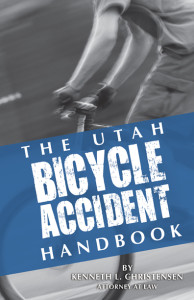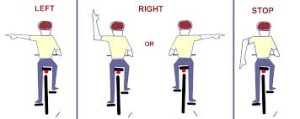Bike riding is a hobby and sport that is shared by young and old, tall and short, women and men. Some of us meander off the routine bike path and head into the mountains and onto dirt paths, while others stick to the road for exercise or in pursuit of becoming diligent cyclists and athletes. If you belong the the road bike group, then you have likely experienced the thrill and danger of sharing the road with cars who don’t pay much attention to you. Some roads are wide open, with views to die for and little to watch out for, but other roads, especially those in the city, are usually congested with pedestrians, cars, motorcycles, and trucks. Congested roads such as these require the bicyclist and the motorist to be more aware of each other. One of the best way to establish this awareness is through the cyclist’s use of hand signals.
There are four important signals that both cyclists and motorists are required to know. As also found in The Utah Bicycle Accident Handbook, these hand signals can be found in the following video, descriptions, and picture.
Left Turn Signal
This is a signal in which the bicyclist extends his left arm all the way out from his body so that his arm is parallel to the road. Do not assume that the motorists see you. Look over your shoulder before you actually start your turn. If you are a motorist and you see a cyclist extending his arm you should slow down and allow the cyclist to start his turn. It is important to maintain a safe distance from the cyclist, especially when they are turning left because they might have to come into traffic lanes instead of staying on the side of the road.
Right Turn Signal
The best right turn signal involves the cyclist extending his right arm parallel to the road, similar to the left hand turn signal. While you should make sure that on-coming cars also see you, this turn is less dangerous than the left hand turn.
Alternative Right Turn Signal
There is an alternative right hand turn signal which involves the cyclist bringing his left hand to the square, or in other words, bringing it to a 90 degree angle. This signal is legal, but it can be confusing to motorists who may think the cyclist wants to turn left.
Stop/Stay Signal
This signal is created by making a square (90 degree angle) with your hand facing the ground. This signal cautions both riders and drivers to be aware that the cyclist is stopping or slowing down because of a traffic sign or because there is something in the road.
Remember
These signals aren’t just good to know, they are required by law. If a cyclist is going to be considered a vehicle and is allowed to share the road, then he or she must be able to communicate with others on the road. So remember these signals and practice making them before you get out on the road. With this reminder, we wish you the best and hope that our words will help you bike and drive a little safer.
If you have been in a bicycle accident due to a motorist who did not understand biking signals, please do not hesitate to contact us at Christensen and Hymas. Our office provides a comfortable and confidential environment for a free consultation. Our number is (801)506-0800.
Photo provided by NYMBlog


